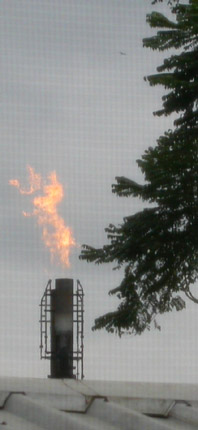NEW! Click on the link below to view a short film on biodiversity and oil production in Yasuní National Park. Features interviews with Kelly Swing and Jaime Guerra.
Yasuní - A Hotspot in Jeopardy
Tambien puedes ver la película "Yasuní: Un Bosque Tropical en Peligro" con subtitulos en español.
My research site is right along the border of Yasuní National Park in Eastern Ecuador. This area, designated a World Natural Hertiage Site and Biosphere Reserve by the United Nations in 1979, is one of the most biodiverse areas on the planet. Surveys in this area have found over 500 species of birds, over 700 plant species, over 150 species of mammals and over 100 species of amphibians - a level of biodiversity comparable to that of the entire united states in an area less than the size of the state of Connecticut.
Yasuní National Park is in great danger due to the economic demands of oil production. Oil accounts for 40% of Ecuador's export revenues, and as a billion dollar industry the national goverment is under intense pressure to utilize oil reserves under Yasuní National Park. Oil extraction is very environmentally destructive, however the extraction itself is a localized and temporary disturbance. A much greater problem is the long-term deforestation as a result of building roads. Oil companies typically build roads to bring equipment and supplies to oil reserves in remote areas. These roads open up 100's of miles of pristine habitat for logging, hunting, farming and colonization, with permanent and devastating effects on the ecosystem, as well as the cultures of indigenous groups. Extracting oil without building roads is more expensive in the short term, since equipment must be transported by air or along rivers, but greatly reduces the long-term loss of biodiversity due to deforestation.


Come for the Galapagos, but stay for the rainforest...
One way the international community can convince the Ecuadorian goverment to work to protect Yasuní National Park is to demonstrate its importance as a world resource. Its designation as a World Biosphere Reserve means very little without publicity. The more people who come to visit the Yasuní area and learn about its amazing biodiversity first hand, the more publicity it receives, the more well-known the park becomes, the more likely it is to be protected. Ecotourism has worked to protect one of Ecuador's other World Biosphere Reserves - the Galapagos islands. Carefully regulated ecotourism in the Galapagos islands brings in hundreds of thousands of dollars every year and provides economic incentive to protect this unique habitat. Ecotourism could provide the same protection to Yasuní National Park, if more people knew of the unique biological experience it represents. While biotourism dollars can not be expected to compete with oil dollars, they could certainly convince the Ecuadorian goverment to prevent oil companies from building roads in order to protect Yasuní National Park as a long-term natural and economic resource.
Learn more about Tiputini Biodiversity Station, where the film above was made.
